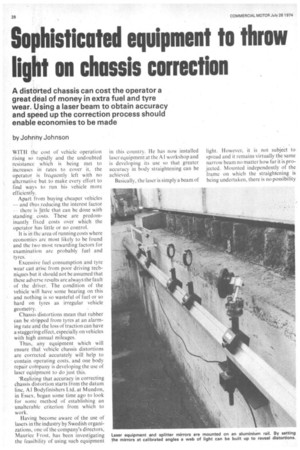Sophisticated equipment to throw light on chassis correction
Page 32

Page 33

If you've noticed an error in this article please click here to report it so we can fix it.
A distorted chassis can cost the operator a great deal of money in extra fuel and tyre wear. Using a laser beam to obtain accuracy and speed up the correction process should enable economies to be made
. by Johnny Johnson WITH the .cost of vehicle operation rising so rapidly and the undoubted resistance which is being met to increases in rates to cover it, the operator, is. frequently left with no alternative hut to make every effort to find ways to run his vehicle more efficiently.
Apart from buying cheaper vehicles -and thus reducing the interest factor there: is little that can be done with standing': costs. These are predominantly fixed costs over which the operator has little or no control.
It is in the area of running costs where economies are most likely to be found and the two most rewarding factors for examination are probably fuel and tyres. ••..
Excessive fuel consumption and tyre wear can arise from poor driving techniques but it should not be assumed that these adverse results are always the fault of the driver. The condition of the vehicle will have some bearing on this and nothing is so wasteful of fuel or so hard on tyres as irregular vehicle geometry.
Chassis 'distortions mean that rubber can be stripped from tyres at an alarming rate-•arid the loss of traction can have a staggering effect, especially on vehicles with high annual mileages.
Thus;, any equipment which will ensure that. vehicle chassis distortions are corrected accurately will help to contain operating costs, and one body repair cohipany is developing the use of laser equipment to do just this.
'Realizing that accuracy in correcting Chassis distortion starts from the datum line, Al I3odyfinishers Ltd, at Mundon, in Essex, began some time ago to look for some method of establishing an • unalterable criterion from which to work. •
Having become aware of the use of lasers in the industry by Swedish organizations, one of the company's directors., Maurice Frost, has been investigating the feasibility of using such equipment
in this country. Ile has now installed laser equipment at the Al workshop and is developing its use so that greater accuracy in body straightening can be achieved.
Basically, the laser is simply a beam of light. However, it is not subject to spread and it remains virtually the same narrow beam no matter how far it is projected. Mounted independently of the frame on which the straightening is being undertaken, there is no possibility of inaccuracy because of the frame being distorted by the force used or by variations in atmosphere and temperature. temperature.
Using aluminium to eliminate any possibility of mounting variation, Maurice Frost has installed a rail along all four walls of the workshop on which the equipment can be mounted in any position. Careful measurement has ensured that this rail is truly horizontal.
Projecting the light beam along the side of the vehicle provides a line with which to ensure that the vehicle on the straightening frame is parallel.
A series of semi-mirrors, mounted on the same beam, is used to deflect the beam at required angles. These mirrors split the beam, allowing one part to pass through to the next mirror and deflecting another part to provide a base line at that part of the chassis at which it is required. The overall effect is that the vehicle is positioned in a web of light beams which reveal shape deviations through a series of perspex gauges.
The gauges are hung at strategic points on the chassis and reveal diamond distortion, twists or kinks according to their position. 4 For instance, the splitter mirror is calibrated to allow particular angles to be selected. Setting a mirror at 45 degrees and projecting the beam through gauges suspended from the spring hanger brackets will show if there is a diamond distortion and whether the wheels are set at true right-angles to the frame.
The beam shows as a dot of light on the gauge and the reading should be at a particular height on each gauge and, because the gauges are hung one immediately behind the other, should be at similar transverse readings on each gauge.
Kinks become evident from the readings obtained through a number of gauges placed laterally along the length of the vehicle.
When force is applied on the Bear equipment, which Al uses to correct faults, the position of the dot of light is altered on the gauge and it is quickly apparent when sufficient force is used. Thus there is no need to apply force, then release it and measure the body geometry a second time to determine the amount of correction which has been made, as formerly. Thus, it should be necessary to apply force only once and tkie former method of correction and release, which might have been necessary on several occasions, is eliminated. Using the laser equipment, then, not ' only makes for greater accuracy but should speed up the process of chassis correction so that the vehicle can be returned to traffic sooner than was formerly possible. Another factor which will tend to reduce overall operating costs.
































































































